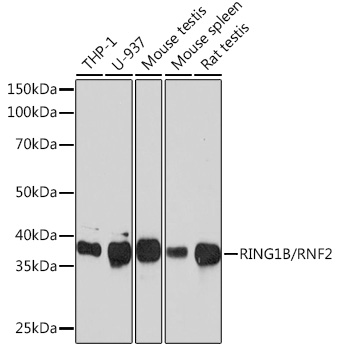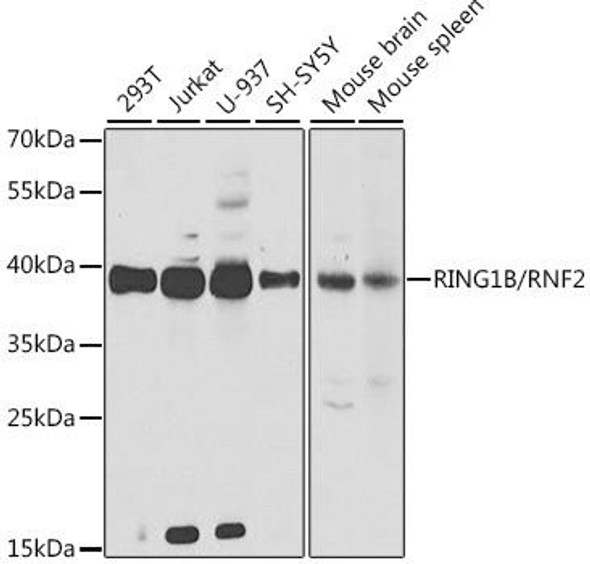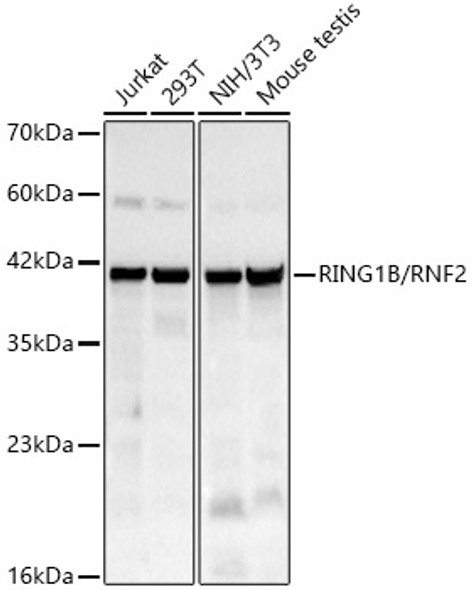Epigenetics & Nuclear Signaling Antibodies 5
Anti-RING1B/RNF2 Antibody (CAB3564)
- SKU:
- CAB3564
- Product Type:
- Antibody
- Reactivity:
- Human
- Reactivity:
- Mouse
- Reactivity:
- Rat
- Host Species:
- Rabbit
- Isotype:
- IgG
- Research Area:
- Epigenetics and Nuclear Signaling
Description
| Antibody Name: | Anti-RING1B/RNF2 Antibody |
| Antibody SKU: | CAB3564 |
| Antibody Size: | 20uL, 50uL, 100uL |
| Application: | WB |
| Reactivity: | Human, Mouse, Rat |
| Host Species: | Rabbit |
| Immunogen: | A synthesized peptide derived from human RING1B/RNF2 |
| Application: | WB |
| Recommended Dilution: | WB 1:500 - 1:2000 |
| Reactivity: | Human, Mouse, Rat |
| Positive Samples: | THP-1, U-937, Mouse testis, Mouse spleen, Rat testis |
| Immunogen: | A synthesized peptide derived from human RING1B/RNF2 |
| Purification Method: | Affinity purification |
| Storage Buffer: | Store at -20'C. Avoid freeze / thaw cycles. Buffer: PBS with 0.02% sodium azide, 0.05% BSA, 50% glycerol, pH7.3. |
| Isotype: | IgG |
| Sequence: | Email for sequence |
| Gene ID: | 6045 |
| Uniprot: | Q99496 |
| Cellular Location: | Chromosome, Nucleus |
| Calculated MW: | 38kDa |
| Observed MW: | 38kDa |
| Synonyms: | BAP-1, BAP1, DING, HIPI3, RING1B, RING2 |
| Background: | Polycomb group (PcG) of proteins form the multiprotein complexes that are important for the transcription repression of various genes involved in development and cell proliferation. The protein encoded by this gene is one of the PcG proteins. It has been shown to interact with, and suppress the activity of, transcription factor CP2 (TFCP2/CP2). Studies of the mouse counterpart suggested the involvement of this gene in the specification of anterior-posterior axis, as well as in cell proliferation in early development. This protein was also found to interact with huntingtin interacting protein 2 (HIP2), an ubiquitin-conjugating enzyme, and possess ubiquitin ligase activity. [provided by RefSeq, Jul 2008] |
| UniProt Protein Function: | RNF2: E3 ubiquitin-protein ligase that mediates monoubiquitination of 'Lys-119' of histone H2A, thereby playing a central role in histone code and gene regulation. H2A 'Lys-119' ubiquitination gives a specific tag for epigenetic transcriptional repression and participates in X chromosome inactivation of female mammals. May be involved in the initiation of both imprinted and random X inactivation. Essential component of a Polycomb group (PcG) multiprotein PRC1-like complex, a complex class required to maintain the transcriptionally repressive state of many genes, including Hox genes, throughout development. PcG PRC1 complex acts via chromatin remodeling and modification of histones, rendering chromatin heritably changed in its expressibility. E3 ubiquitin- protein ligase activity is enhanced by BMI1/PCGF4. Acts as the main E3 ubiquitin ligase on histone H2A of the PRC1 complex, while RING1 may rather act as a modulator of RNF2/RING2 activity. Component of chromatin-associated Polycomb (PcG) complexes. Part of the E2F6.com-1 complex in G0 phase composed of E2F6, MGA, MAX, TFDP1, CBX3, BAT8, EUHMTASE1, RING1, RNF2/RING2, MBLR, L3MBTL2 and YAF2. Component of a PRC1-like complex. Component of some MLL1/MLL complex, at least composed of the core components MLL, ASH2L, HCFC1/HCF1, WDR5 and RBBP5, as well as the facultative components C17orf49, CHD8, E2F6, HSP70, INO80C, KANSL1, LAS1L, MAX, MCRS1, MGA, MYST1/MOF, PELP1, PHF20, PRP31, RING2, RUVB1/TIP49A, RUVB2/TIP49B, SENP3, TAF1, TAF4, TAF6, TAF7, TAF9 and TEX10. Interacts with RYBP, HIP2 and TFCP2. Association to the chromosomal DNA is cell-cycle dependent. Component of repressive BCOR complex containing Polycomb group subcomplex at least composed of RYBP, PCGF1, BCOR and RING1. Interacts with Interacts with PCGF2, CBX4, CBX6, CBX7 and CBX8. Interacts with CBX2, BMI and PHC2. Interacts with RYBP, HIP2 and TFCP2. |
| UniProt Protein Details: | Protein type:Ubiquitin ligase; EC 6.3.2.-; EC 6.3.2.19; Ligase; Ubiquitin conjugating system Chromosomal Location of Human Ortholog: 1q25.3 Cellular Component: nucleoplasm; nucleus; PcG protein complex; ubiquitin ligase complex Molecular Function:chromatin binding; protein binding; ubiquitin-protein ligase activity; zinc ion binding Biological Process: negative regulation of transcription factor activity; negative regulation of transcription from RNA polymerase II promoter; protein sumoylation |
| NCBI Summary: | Polycomb group (PcG) of proteins form the multiprotein complexes that are important for the transcription repression of various genes involved in development and cell proliferation. The protein encoded by this gene is one of the PcG proteins. It has been shown to interact with, and suppress the activity of, transcription factor CP2 (TFCP2/CP2). Studies of the mouse counterpart suggested the involvement of this gene in the specification of anterior-posterior axis, as well as in cell proliferation in early development. This protein was also found to interact with huntingtin interacting protein 2 (HIP2), an ubiquitin-conjugating enzyme, and possess ubiquitin ligase activity. [provided by RefSeq, Jul 2008] |
| UniProt Code: | Q99496 |
| NCBI GenInfo Identifier: | 62901044 |
| NCBI Gene ID: | 6045 |
| NCBI Accession: | Q99496.1 |
| UniProt Secondary Accession: | Q99496,Q5TEN1, Q5TEN2, B2RBS7, B3KRH1, |
| UniProt Related Accession: | Q99496 |
| Molecular Weight: | 29,258 Da |
| NCBI Full Name: | E3 ubiquitin-protein ligase RING2 |
| NCBI Synonym Full Names: | ring finger protein 2 |
| NCBI Official Symbol: | RNF2 |
| NCBI Official Synonym Symbols: | BAP1; DING; BAP-1; HIPI3; RING2; RING1B |
| NCBI Protein Information: | E3 ubiquitin-protein ligase RING2 |
| UniProt Protein Name: | E3 ubiquitin-protein ligase RING2 |
| UniProt Synonym Protein Names: | Huntingtin-interacting protein 2-interacting protein 3; HIP2-interacting protein 3; Protein DinG; RING finger protein 1B; RING1b; RING finger protein 2; RING finger protein BAP-1 |
| Protein Family: | E3 ubiquitin-protein ligase |
| UniProt Gene Name: | RNF2 |
| UniProt Entry Name: | RING2_HUMAN |
View AllClose





![Anti-RING1B/RNF2 Antibody (CAB18076)[KO Validated] Anti-RING1B/RNF2 Antibody (CAB18076)[KO Validated]](https://cdn11.bigcommerce.com/s-rd6ounxcu2/images/stencil/590x590/products/55218/59961/anti-ring1brnf2-antibody-cab18076ko-validated__43645__24550.1706529206.jpg?c=1)

